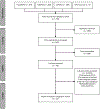Integrative Review of Early Life Adversity and Cortisol Regulation in Pregnancy
- PMID: 33524324
- PMCID: PMC8113070
- DOI: 10.1016/j.jogn.2020.12.006
Integrative Review of Early Life Adversity and Cortisol Regulation in Pregnancy
Abstract
Objective: To synthesize published findings on the relationship between early life adversity and hypothalamic-pituitary-adrenal axis cortisol parameters in pregnant women.
Data sources: We searched PubMed, CINAHL, and PsycINFO databases using variants and combinations of the keywords early life adversity, pregnancy, hypothalamic-pituitary-adrenal axis, and cortisol.
Study selection: We selected articles that included pregnant participants, included measures of cortisol and early life adversity, were published in English in a peer-reviewed journal, and were of sufficient methodologic quality. Date of publication was unrestricted through May 2020.
Data extraction: Twenty-five articles met the inclusion criteria and were evaluated for quality and risk of bias. Sources of cortisol included saliva, hair, plasma, and amniotic fluid.
Data synthesis: We categorized findings according to four physiologically distinct cortisol output parameters: diurnal (daily pattern), phasic (in response to an acute stressor), tonic (baseline level), and pregnancy-related change. Preliminary evidence suggests that early adversity may be associated with elevated cortisol awakening response (diurnal) and blunted response to acute stressors (phasic), irrespective of other psychosocial symptoms or current stress. For women with high levels of current stress or psychological symptoms, early adversity was associated with higher baseline (tonic) cortisol levels.
Conclusion: Early life adversity in women is linked with alterations in cortisol regulation that are apparent during pregnancy. Researchers should examine how variations in each cortisol parameter differentially predict pregnancy health risk behaviors, maternal mental health, and neonatal health outcomes.
Keywords: abuse; adverse childhood experiences; hypothalamic–pituitary–adrenal axis; neuroendocrine; prenatal; toxic stress; trauma.
Copyright © 2021 AWHONN, the Association of Women’s Health, Obstetric and Neonatal Nurses. Published by Elsevier Inc. All rights reserved.
Conflict of interest statement
Conflict of Interest The authors report no conflicts of interest or relevant financial relationships.
Figures
References
-
- Bernstein DP, Fink L, Handelsman L, Foote J, Lovejoy M, Wenzel K, Sapareto E, & Ruggiero J (1994). Initial reliability and validity of a new retrospective measure of child abuse and neglect. The American Journal of Psychiatry, 151(8), 1132. - PubMed
Publication types
MeSH terms
Substances
Grants and funding
LinkOut - more resources
Full Text Sources
Other Literature Sources
Miscellaneous


